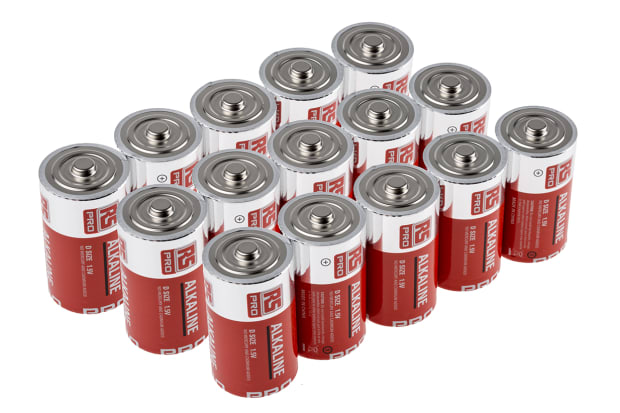- Published Mar 8, 2023
- Last Modified Aug 29, 2023
- 4 min
A Guide to D Batteries
Both non-rechargeable and rechargeable D batteries are suitable for a range of uses. Discover more in our guide.

This guide will explain all about the different types of D battery, what they’re used for, and which brands you should be buying.
What are D Batteries?
D batteries are a standard size of ‘dry cell’ battery. These are the easily interchangeable models widely used in electronic and domestic devices. The term ‘dry cell’ is used to distinguish them from more specialist ‘wet cell’ batteries which, as the name suggests, contain liquid.
What does a D size battery look like? Typically, they are squat and solid, with a barrel-like shape. The positive contact point or terminal on the top of each battery has a distinct metal cap shape.
D batteries were first invented in 1898. Today, they are also known as R20s, after their designation by standards body the International Electrotechnical Commission (IEC).
D size batteries are available as both standard non-rechargeable and rechargeable models.
What Size is a D Battery?
The standard size of D battery is:
- Diameter: 33.2 mm/1.3 inches
- Length: 61.5 mm/2.42 inches
How Much Does a D Battery Weigh?
At an average weight of 160-180 grams each, they are one of the larger D cell battery sizes and so are ideal for devices that require a high level of power over an extended period, consumption that would quickly drain smaller capacity batteries.
Flashlight Batteries
Due to their long-standing use in large, power-hungry torches, D batteries are often called ‘flashlight batteries’, after the US term for torch.
Both rechargeable and non-rechargeable D batteries can be used in torches but rechargeable flashlight batteries are sometimes preferred as they can easily be recharged and reused.

What are D Batteries Used for?
In addition to high power torches, we have detailed some other common uses for the D size battery below. These are all devices with above-average current requirements, making them well suited for use with D size batteries.
Common Uses for D Batteries:
- Radio receiving and transmitting equipment
- Electric motors
- Electronic toys
- Megaphones
What Voltage are D Batteries?
Standard D batteries offer a voltage of 1.5 volts. This is a routine figure for dry cell batteries - C, AA and AAA batteries are all 1.5 volts too.
However, the standard D battery voltage is not the end of the story. The current produced by different battery sizes is also key. Voltage is equivalent to pressure or momentum, propelling the current out of the battery, while current is the actual power produced.
Many electronic devices require additional current but may not require additional voltage.
Typically, rechargeable batteries feature a slightly milder 1.2V.
How Long Do D Size Batteries Last?
D batteries are ideal for such demanding devices because they produce a high level of current. The precise amount varies according to brand and circumstances, but an average D battery could be expected to produce a current of approximately 10,000 mAh (milliamps per hour).
A milliamp is 1,000th of an amp - the standard unit of electrical charge. A high current consumption rate of 500mAh (milliamps per hour) would give a battery life of around 14 hours before replacement or recharge is required.
Batteries are often listed with an ‘Ah’ rating, meaning ‘amp hour’. A 2.5 Ah rating means that the battery would last for two and a half hours if drained at a rate of precisely one amp per hour. However, it’s worth noting that this is a purely theoretical figure used for comparative purposes as real-world power usage does not take place at a steady rate.
Rechargeable D Batteries vs Non-Rechargeable D Batteries
As we have already noted, like many other sizes, D batteries are also available in environmentally-friendly rechargeable models. Instead of replacing a spent battery, all the user needs to do is remove the rechargeable D battery and insert this into a compatible charger to be recharged and reused.
Typically, rechargeable D cell batteries have a higher capacity than standard models.
The two principal types of rechargeable battery are nickel-cadmium (NiCd) and its close variant nickel-metal hydride (NiMH). Both use nickel-metal hydroxide as an ‘electrolyte’ (electricity-conducting substance). Rechargeable D cells are designated KR20 for NiCd models and HR20 for NiMH models.
What Are the Best Rechargeable and Non-Rechargeable D Batteries?
As D batteries are a standard size, you will not be surprised to hear that all the major manufacturers produce D batteries.
Please see the D battery sizes chart below for some examples of key brands and products: